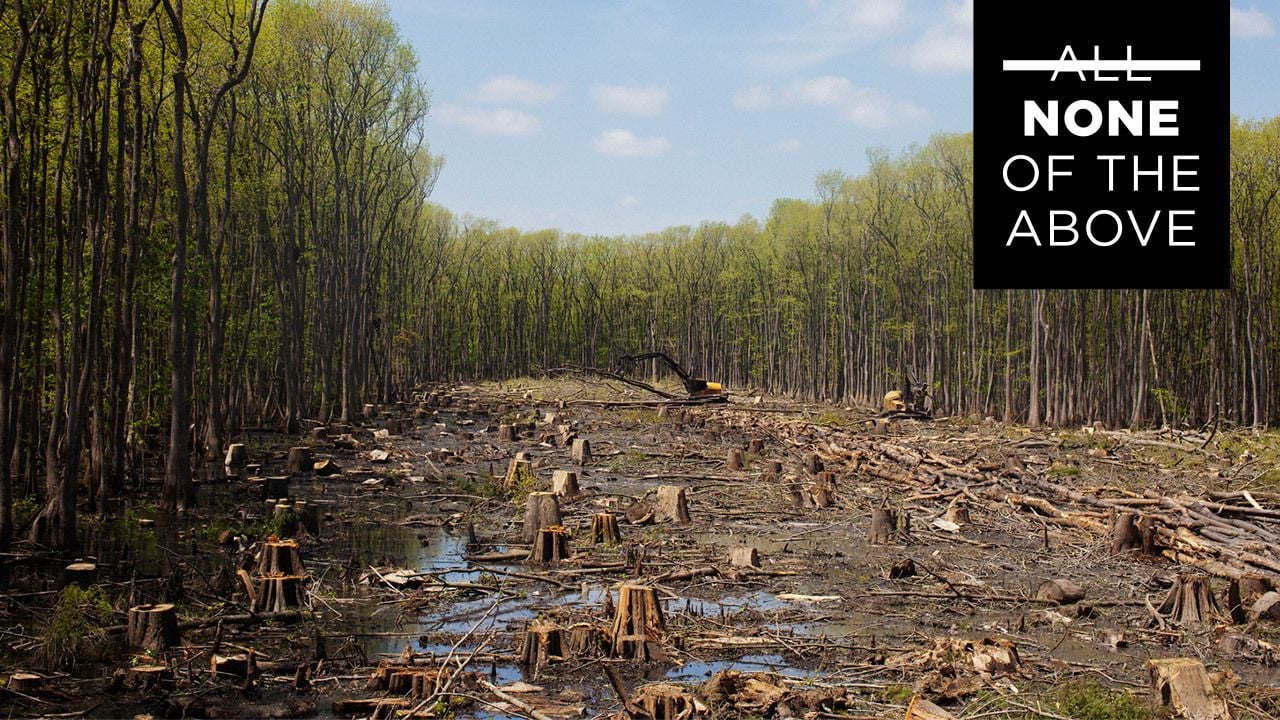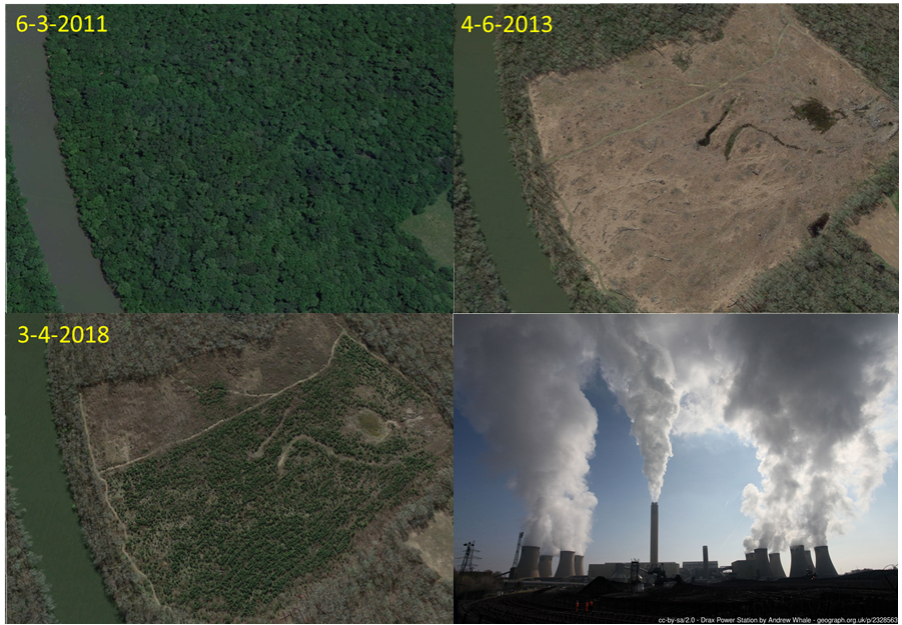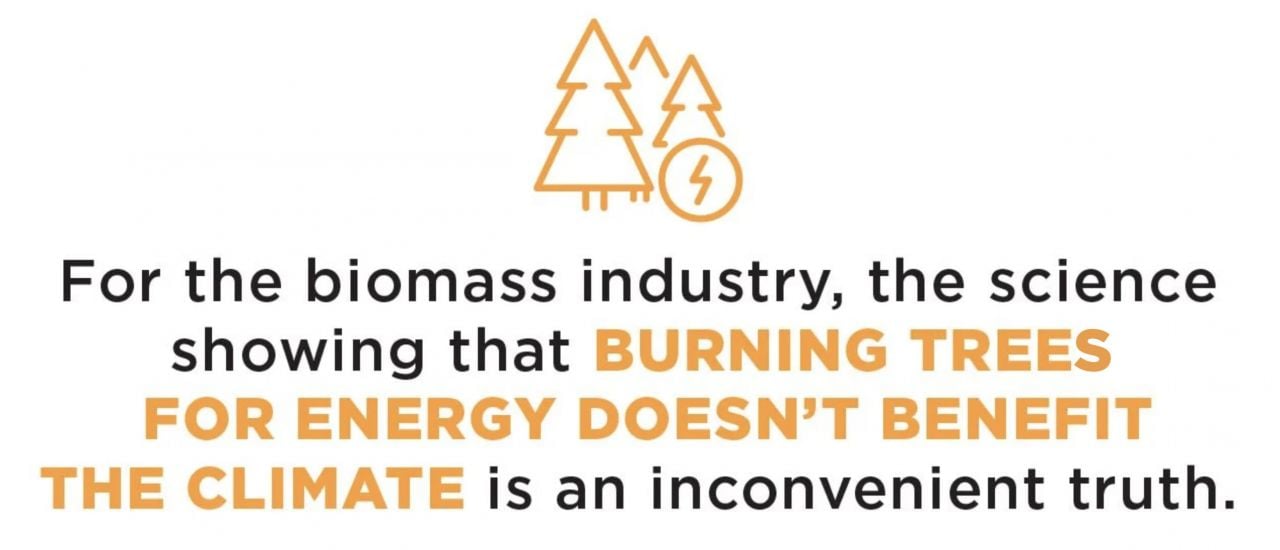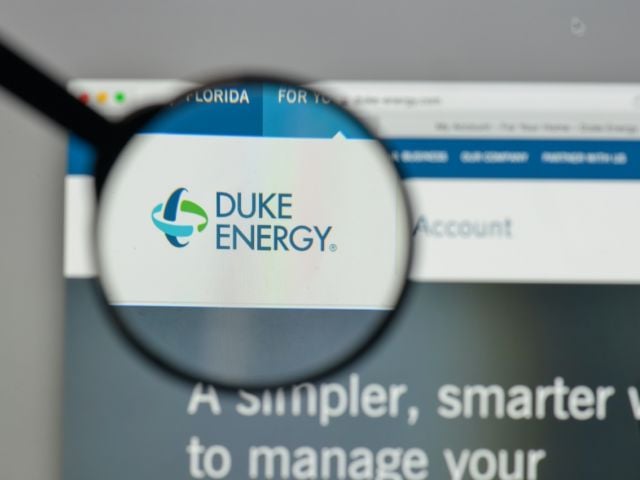
Fourth in a series.
To avert the worst impacts of the climate crisis, not only must we drastically cut emissions but we must also remove carbon dioxide from the atmosphere. For this, no technological solution can match protecting and restoring natural forests, which take carbon pollution out of the atmosphere and transform it into tree carbon and soil carbon.
But the Biden administration’s renewable energy plans appear likely to include logging and burning trees for so-called biomass energy, which pumps carbon into the atmosphere – the exact opposite of what we must do to mitigate climate change.
Burning trees and other biomass is often erroneously categorized as zero-carbon or carbon neutral energy. But while burning biomass instead of fossil fuels may produce paper “reductions” in emissions, the atmosphere is not fooled.
The fact is that burning wood emits more carbon pollution per unit of energy than even coal. And because burning wood adds carbon to the atmosphere much faster than trees can grow back to sequester it, replacing fossil fuels with forest wood can increase net greenhouse gas emissions for decades or even centuries.

For the disastrous consequences of a policy that pays people to burn trees for energy, the European Union and Britain are prime examples. Bioenergy incentives are driving catastrophic levels of illegal logging in the last ancient forests of Eastern Europe and have created an export wood-pellet industry in the U.S., Canada, Russia and the Baltics that did not even exist 10 years ago. Entire forests are felled, ground up, turned into pellets and sent up smokestacks in the EU, the U.K., Japan and Korea.
The Google Earth images below show an example of the scale of this folly. The wood harvested from this 67-acre clear-cut of North Carolina native forest by Enviva, the largest wood pellet company in the world, would run the wood-burning units at the U.K.’s Drax power station for about three and a half hours.
Drax formerly ran solely on coal. Now it continues to burn coal but also collects about $2.8 million per day in renewable energy subsidies for its wood-burning units – money paid by unsuspecting U.K. ratepayers who think they are supporting clean energy.

A 67-acre tract of hardwood forest in North Carolina before, just after and five years after logging, including replacement of the biodiverse forest with a pine plantation. The wood harvested would run the Drax power station’s wood-burning units for almost three and a half hours.
Hefty “clean energy” subsidies have driven the biomass boom in Europe, but in the U.S., sparser subsidies leave biomass too expensive to compete with cheap natural gas and clean renewables. But as part of a post-pandemic recovery program, new federal mandates and incentives could pump money into the biomass industry.
This was a serious flaw in the Obama administration’s 2009 stimulus package. An infusion of cash caused a surge in biomass power plant construction. But among the 25 projects that got $10 million or more in stimulus funds, there were numerous cost overruns, air and water violations, early closures and lawsuits, and utilities made long-term power purchase deals that inflated ratepayers’ electricity bills.
Will the Biden administration repeat this mistake by throwing money and resources at the wasteful, polluting biomass power industry – or will it, as the president promised on his first day in office, “listen to the science”?
The wood pellet industry would love to create a domestic market rivaling the one overseas – and it may have an ally in Agriculture Secretary Tom Vilsack. In his previous turn in the same post in the Obama administration, Vilsack was an aggressive proponent of tree-burning, repeating cringe-worthy unscientific claims about wood-burning being sustainable and climate-friendly.

Biomass “carbon accounting” can seem complicated, but it boils down to a very simple concept.
There are two main pools of carbon – forest carbon and atmospheric carbon. Policies that increase the forest carbon pool shrink the atmospheric pool. But policies that raze forests, like harvesting them for fuel, add carbon pollution to the atmosphere.
The Biden administration wants to meet the Paris climate agreement goal of achieving economy-wide “net zero” emissions – balancing greenhouse gas emissions and CO2 uptake – by 2050. In his executive order on climate, Biden committed to an earlier goal of a “carbon pollution-free” electricity sector no later than 2035.
The most effective way to store carbon is through the restoration and protection of natural forests. This approach would also provide innumerable other benefits to biodiversity, wildlife habitat, flood regulation, soil stabilization and local climate. But we have a long way to go: Far from balancing emissions, CO2 uptake by U.S. forests and other land offset less than 12 percent of the country’s emissions in 2018. Worse, the forest carbon sink is becoming weaker: U.S. lands now sequester only about 90 percent of the carbon each year that they did in 1990.
To reverse this trend and set a course toward net zero emissions, the Biden administration should let a simple question guide every decision on renewable energy, lands and climate: Will this policy increase, or decrease, ecosystem health and carbon storage and uptake in U.S. forests quickly enough to meet our climate goals?
The bioenergy debate in the U.S. has been complicated by the increase in wildfires in Western forests. An oft-repeated argument is that thinning forests will produce climate benefits by reducing fire frequency and intensity – even though the scientific evidence is negligible. In reality, though measures to reduce fire risk in residential areas are common sense, extensive logging in the backcountry for fire mitigation is expensive and impractical and can serve as a large net source of carbon pollution. Meanwhile, such programs generate a lot of wood that must be disposed of, giving a leg up to the biomass industry.
For the biomass industry, the science showing that burning trees for energy doesn’t benefit the climate is an inconvenient truth. In the past several years, the tree-burning lobby has worked with friendly staff at the Department of Agriculture and the Environmental Protection Agency, and legislators like Sen. Susan Collins of Maine, to enact policies that would by fiat declare forest biomass “carbon neutral.” The Biden administration has put the brakes on such policies that the Trump administration left pending, but the biomass industry is still working overtime to include biomass as a “clean” and “carbon free” energy source in federal energy policy.

The record of the previous Democratic administration and climate allies in Congress on biomass is not stellar.
The 2009 American Clean Energy and Security Act – also known as the Waxman-Markey bill – relied heavily on replacing coal with wood for “reducing emissions,” simply not counting the carbon pollution this would emit. The Obama EPA’s Clean Power Plan, which sought to reduce power sector emissions, left the door open to burning biomass as a “zero emissions” fuel. The EPA administrator at that time was Gina McCarthy, who now serves as the Biden administration climate czar but who has since learned about the depredations of the wood pellet industry during her time heading up the Natural Resources Defense Council.
Ironically, it was the Trump EPA, in the Affordable Clean Energy rule, that recognized that biomass would not help reduce coal plant emissions, because “combustion of biomass emits more mass of emissions per Btu [British Thermal Units] than that from combustion of fossil fuels, thereby increasing CO2 emissions at the source.”
As the EPA crafts a plan for reducing power sector emissions, will the agency once again rely on the false climate solution of biomass, or will it prioritize protecting and restoring carbon stocks in forests and other land?
It’s important that Michael Regan, the new EPA administrator, formerly ran the Department of Environmental Quality in North Carolina, which is ground zero for the wood pellet industry’s forest exploitation. He's on record saying that he doesn’t buy claims that burning wood is carbon neutral, and he doesn’t see much of a future for the wood pellet industry – but has been taken to task for a weak response on environmental justice issues raised by wood pellet manufacturing in North Carolina.
The environmental justice impacts of biomass energy are likely to play a more important role with the Biden administration than in the past, particularly given how air pollution appears to exacerbate the impacts of Covid-19. It’s no surprise that highly polluting biomass power plants, as well as pellet-manufacturing facilities, are disproportionately located in lower-income communities, even as they benefit from subsidies and incentives as “clean energy.”
Although large-scale biomass power plants generally use modern emissions controls, they still emit tens of tons of fine particulate pollution per year – pollution linked to health hazards including asthma, cancer, low birth weight, and now Covid-19 mortality. The biggest source of pollution from biomass is residential wood burning – a disproportionate source of fine particulate matter yet one promoted by some legislators as worthy of clean energy subsidies.
When it comes to creating new incentives for burning wood, biomass boosters are endlessly inventive. Besides legislation to promote residential wood-burning as renewable energy, there’s an ongoing effort to classify electricity from biomass as a “renewable fuel” in vehicles, so wood-burning power plants can benefit from the same subsidies as another bioenergy disaster, corn ethanol. Biomass is always showing up in “clean energy” legislation. State-level renewable energy mandates and other incentives are widespread, as in Maine, where the biomass industry has burned through more than a quarter of a billion dollars in incentives trying to stay afloat.
If the Biden administration wants to achieve “net zero” emissions goals, it must strengthen forests to help fight climate change and resist the slippery double-talk and backwards science of the biomass industry. (We have to log forests to save them! Burning trees reduces emissions!)
But given their past records, it’s not clear if Biden’s EPA, USDA and climate team are willing to stand up to the forestry and biomass industries.
The story of their efforts will ultimately be reflected in the yearly reports on sources and sinks for carbon, forest growth and biomass emissions. We’ll be able to see on an annual basis whether emissions are going down, whether forest carbon uptake is increasing – and just how much forest carbon is going up smokestacks in the name of “clean energy.” The Biden team must vault over the mistakes of the past and avoid the disastrous pro-bioenergy policies that the E.U. fell for.
Mary S. Booth is director of the Partnership for Policy Integrity.
Photo credit: Matt Eich
Resources from the author
Booth, Mary S. 2014. Trees, Trash, and Toxics: How Biomass Energy Has Become the New Coal. Pelham, MA: Partnership for Policy Integrity. http://www.pfpi.net/wp-content/uploads/2014/04/PFPI-Biomass-is-the-New-Coal-April-2-2014.pdf
Bitov, Kelly, and Mary S. Booth. 2014. Climate of Deception: Why electricity consumers who care about global warming and air pollution need FTC protection from biomass industry greenwashing. Pelham, MA: Partnership for Policy Integrity. http://www.pfpi.net/wp-content/uploads/2014/07/PFPI-report-to-FTC-on-biomass-power-greenwashing.pdf
Booth, Mary S. 2016. Carbon Emissions and Climate Change Disclosure by the Wood Pellet Industry – A Report to the SEC on Enviva Partners LP. Pelham, MA: Partnership for Policy Integrity. http://www.pfpi.net/wp-content/uploads/2016/03/Report-to-SEC-on-Enviva-March-14-2016.pdf
Booth, Mary S. 2017. Maine Bioenergy at the Crossroads: Costs of a Failing Industry. Pelham, MA: Partnership for Policy Integrity. http://www.pfpi.net/wp-content/uploads/2017/04/PFPI-Maine-Biomass-Report-4-18-17.pdf
Booth, Mary S. 2018. "Not carbon neutral: Assessing the net emissions impact of residues burned for bioenergy." Environmental Research Letters 13 (3):035001. http://iopscience.iop.org/article/10.1088/1748-9326/aaac88/meta
Booth, Mary S., and Brett Leuenberger. 2018. The Bioenergy Boom from the Federal Stimulus: Outcomes and Lessons. Pelham, MA: Partnership for Policy Integrity. http://www.pfpi.net/wp-content/uploads/2018/10/PFPI-Bioenergy-and-the-Stimulus-Oct-24.pdf
Horwitt, Dusty, and Mary S Booth. 2019. Petition to the Securities and Exchange Commission for a rulemaking on biogenic carbon claims. Pelham, MA: Partnership for Policy Integrity. http://www.pfpi.net/bio-beware-pfpi-investors-petition-sec-to-crack-down-on-biomass-climate-claims


